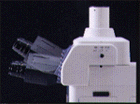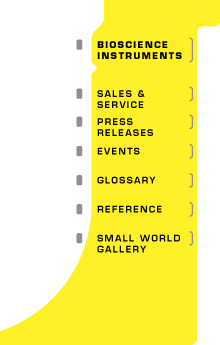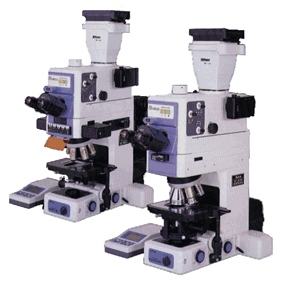The E1000 provides ideal viewing conditions in an instant via Auto Link Focusing and Auto Koehler Illumination.
|
Every time you change objectives the E1000 automatically sets the ideal viewing conditions.
When the nosepiece switch is used to change to another objective lens, up to
seven micromotors are activated instantaneously to set the optimum aperture
and field stop, brightness, condenser lens, macroslider and other items
automatically. Ideal viewing conditions under Koehler illumination are
quickly obtained, always taking maximum advantage of the CFI60 system's superior optical performance. In addition, the Auto Link Focusing (ALF) system
performs automatic correction of focal points. All these interconnected
switching operations rapidly take place without the user having to think about adjusting anything, unless he wants to. In fact, switching speed with the E1000 is the fastest in the world when compared with other microscopes in its class (true as of November 1997).
|

|
|
Auto Link Focusing (ALF) system
ALF is an innovative new system that memorizes individual focal points
which differ slightly from objective to objective, eliminating the need to
fine-adjust the focus manually each time the objective is changed.
|

|
The E1000's natural human interface can be experienced most directly in the
coaxial coarse/fine focus knob. Since the rotation of this knob is detected
by a rotary encoder which then operates a system of motors, the researcher
can use the E1000 without being aware that it is a motorized microscope.
|
Stage movement accuracy of 100 µm is assured in a single rotation of the fine focus knob. Lowering and raising of the stage is extremely smooth, with fine movements of 0.05 µm pitch and coarse movements of 2.5 µm pitch. There
is no awareness of pitch even when using high-magnification objectives.
|
Nosepiece and condenser control system of high accuracy and durability
The revolving nosepiece and condenser, which require highly accurate
positioning, are operated by a combination of mechanical and electric
controls to ensure accuracy and durability. Furthermore, errors that occur
as a result of changes in the microscope as it ages are automatically
corrected by an active correction mechanism.
|

|
Minute nosepiece control designed for oil and water immersion objectives
When switching objectives to oil or water immersion types, the rotating
movement of the nosepiece automatically stops halfway between the objectives; this makes refilling the liquid much easier.
|

|
RS-232C interface
The E1000 is programmable and will accept commands from its RS-232C
interface provided. Since the microscope is designed to be controlled by a computer, it is easy to extend its range of possible applications with digital imaging systems and software.
|
|
Standard Set-Up is Quick and Easy, Using a Bar Code System
Data entries reduced by up to 80%
Simply scan the appropriate bar codes for each of the objectives mounted on the
nosepiece, and all corresponding settings, including optimum apertures and
field stops, brightness, filter and other settings required for automatic
Koehler illumination, will be memorized. The focal positions needed for ALF
to work are also quickly entered with the help of the bar code instructions. The number of data entries for microscope set-up is thus reduced by as much as 80% compared to Nikon's previous models.
|

|
Set-Up Data Entry is a "zip-zip" job using bar codes
After the objectives are mounted on the nosepiece:
- First use the bar code reader to enter the nosepiece position from the bar code chart.
- Then use the bar code reader to enter objective lens type from the bar code chart.
Do this for each objective and the basic set-up is complete!
|
|
The Ideal Viewing Environment for Each Researcher Stored on a Smart Card for Instant Recall
Manual adjustments made to adjust apertures and field stops, brightness
and other items following the standard set-up can be stored on an IC smart
card for instant recall. Since settings vary depending on the
researcher and the specimens being viewed, they can be quickly re-entered
into the E1000 with perfect accuracy. This time-saving feature is
convenient when viewing or comparing large volumes of specimens under
identical conditions, or when more than one researcher is using the E1000.
Using the "Smart Card" is simple
Insert a "Smart Card" and "scan" the bar code "smart card write enable." The "Smart Card" will hold the last setting for each objective after the "smart card write protection" bar code is scanned.
- Perform standard set-up.
- Make manual corrections.
- Operate the rotating switch.
Customized set-up is complete!
|

|






 ECLIPSE E1000 Series
ECLIPSE E1000 Series
